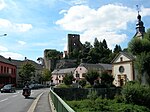Hesperange

Hesperange (French pronunciation: [ɛspəʁɑ̃ʒ]; Luxembourgish: Hesper [ˈhæspɐ] ; German: Hesperingen) is a commune and town in southern Luxembourg. It is located south-east of Luxembourg City. The total population of the commune is 14.701 people. This breaks down into 6.909 Luxembourgers, 2.021 French, 1.758 Portuguese, 1.052 Italians, 627 Belgians, 514 Germans, 241 Spanish, 207 British, 190 Polish, 106 Dutch, and 1.076 persons of other nationalities. (2014 official data) As of 2008, the town of Hesperange, which lies in the centre of the commune, has a population of 2.651. Other towns within the commune include Alzingen, Fentange, Howald, and Itzig. Each of these five towns has a population of over 1,000, making Hesperange unique amongst Luxembourgish communes in having five towns with over a thousand inhabitants (see: List of towns in Luxembourg by population). Hesperange Castle, now a ruin, has a history dating from the 13th century.Hesperange has a park called Hesper Park which has a memorial commemorating the death of three American soldiers who died in a tank accident on the nearby bridge over the Alzette river on 26 December 1944 during the Battle of the Bulge.
Excerpt from the Wikipedia article Hesperange (License: CC BY-SA 3.0, Authors, Images).Hesperange
Rue de Bettembourg,
Geographical coordinates (GPS) Address Nearby Places Show on map
Geographical coordinates (GPS)
| Latitude | Longitude |
|---|---|
| N 49.5708 ° | E 6.1514 ° |
Address
Rue de Bettembourg
Rue de Bettembourg
5862
Luxembourg
Open on Google Maps








